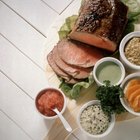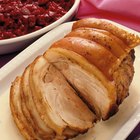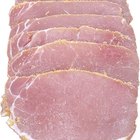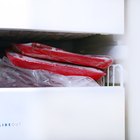Gilles_Paire/iStock/GettyImages
Freezing is a remarkably effective method of preserving food for long periods, but it isn't entirely foolproof. Most foods deteriorate somewhat while they're in your freezer, especially if you open it often enough for the temperature to fluctuate. A common result of extended storage is freezer burn, the formation of gray-brown discolored patches on the surface of meats and other foods. While you probably should throw out small pieces of meat if they're freezer burnt, larger cuts, such as roasts, can usually be salvaged.
Burning With Cold
When a piece of meat is frozen, the liquids within the muscle cells are transformed into the equivalent of millions of tiny ice crystals. If the meat is vacuum-sealed in an airtight bag, as it is in commercial meatpacking plants, it retains its quality for a long time. If it's home-packaged in freezer bags, the meat's lifespan is shortened by the presence of air pockets inside the packaging. Ice crystals within the meat are drawn to the area where air is available, essentially freeze-drying the surface of the roast in that spot. The dry tissues quickly develop rancid flavors as their fats and flavor compounds react with oxygen in the air, oxidizing and forming unpleasantly rank flavors.
Safe, But Not Fun
As long as the roast has stayed frozen throughout its storage time, it will remain food safe to eat even if it has freezer burn. Although it's still safe to eat, it will probably not taste good. The freeze-drying effect of freezer burn leaves that area of the meat's surface dried to a cardboardlike consistency, and its flavor is equally distasteful. Enterprising cooks sometimes try to mask the effects of freezer burn with sauces, but it doesn't really work. The only real solution is to cut away the affected area, an option that can salvage most roasts.
Salvaging Your Roast
To launch your salvage operation, thaw the roast in your refrigerator for 12 to 36 hours, depending on its size. It will be easier to cut if it's thawed at the surface but still slightly frozen underneath. Place the roast on a clean cutting board and trim away any areas that show freezer burning, cutting up to 1/4 inch deep, or as needed, to remove the damaged meat. If your roast is rolled and tied, and if the freezer burnt area overlaps a seam in the roast, cut the twine and inspect the inner areas for freezer damage. Trim them as needed, then roll and re-tie the roast with butcher's twine. Season the trimmed-down roast, and prepare it according to your favorite recipe.
Minimizing Freezer Burn
It's said that an ounce of prevention is worth a pound of cure, and it's certainly possible to lose a pound of your roast to freezer burn. To minimize the impact on your grocery bill, give your meats the best possible wrapping. A vacuum food sealer is best, but if you don't have one, make an effort to squeeze out as much air as possible from your freezer bags. Wrapping your meats tightly in cling wrap before bagging them can help, or alternatively double-bagging your meats. Use adhesive labels to date every package, and make an effort to use the oldest packages first. The slight extra effort will pay off in higher-quality frozen meats, and less freezer burn.
Related Articles

How to Defrost a Frozen 4 Lb Roast

Can I Cut Freezer-Burn Off a Tuna Steak ...
How Long Can You Marinate Meat Before ...
Can You Use Stew Meat That Has Been ...

Does Cooking a Pork Roast Frozen Help ...

Rules for Thawing and Refreezing Meat

How Do I Tell If Pork Has Turned Bad?

How Long Do You Keep Meat in Freezer?

How to Get Sticker Residue Off of Suede ...

How to Cook a Roast in a Browning Bag ...

Is a Roast Bad If It Turns Brown?

Does a Dry Rub Meat Tenderizer Need to ...

How to Cook Freezer-Burnt Pork Chops

Can I Make a Roast From a Frozen State?

How Long Can You Freeze a Roast?

How to Cook a 15-Pound Rib Roast

Can You Freeze Raw Oysters?

What Happens if Meat Unfreezes and Then ...

How to Cook Freezer-Burnt Pork Chops

How to Tell if Seafood Has Freezer Burn
References
- On Food and Cooking: The Science and Lore of the Kitchen; Harold McGee
- U.S. Department of Agriculture Food Safety and Inspection Service: Freezing and Food Safety
- U.S. Food and Drug Administration: Food Storage Chart
Writer Bio
Fred Decker is a trained chef and prolific freelance writer. In previous careers, he sold insurance and mutual funds, and was a longtime retailer. He was educated at Memorial University of Newfoundland and the Northern Alberta Institute of Technology. His articles have appeared on numerous home and garden sites including GoneOutdoors, TheNest and eHow.